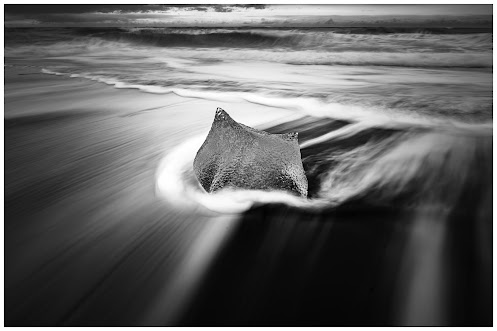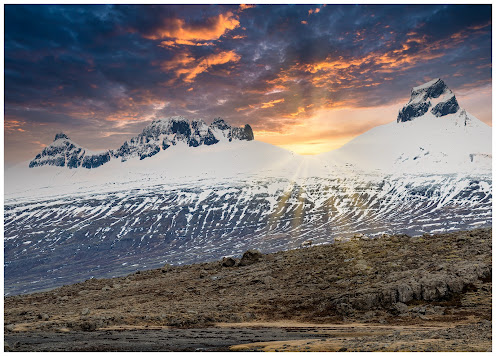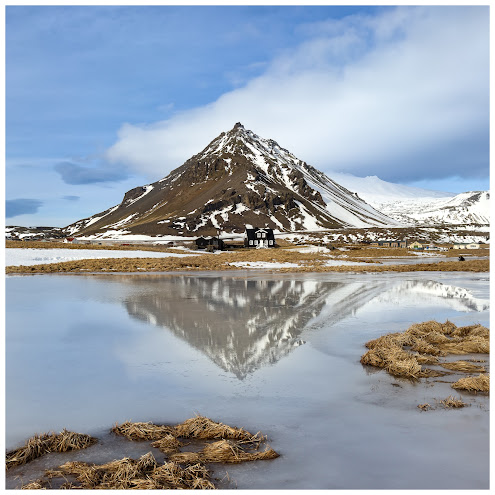The first two weeks in March my son and I participated in a small, bespoke photography workshop in Iceland. In addition to the two of us, there was one other participant and the leader. Over the course of the workshop we traveled the Ring Road (Iceland's Highway 1) in a 9-pax Mercedes Sprinter Van, documenting the many amazing geographic and meteorological scenes we came across. I returned home with nearly 5,000 images (includes those shot on the iPhone 15 Pro Max). The map below show most of the stops we made during the trip. While there is a fairly comprehensive series of blue dots along the country's perimeter, there are a few notable empty areas. Next trip, and there will be a next trip, we'll explore two of those notable empty areas, the West Fjords and the Highlands.
Iceland is an amazingly beautiful country. Incredible scenery, friendly people, all of whom speak excellent English, and great food (loved the seafood!). I was a bit worried about visiting Iceland in winter but it proved not be too challenging. For the most part, temperatures were in the low 30s to low 40s (Fahrenheit) - actually much the same as my home in Strasburg, Virginia. Over the course of the trip we endured some rain, some sleet and some snow. In fact on the next to last day on island we were in white out conditions at various times while driving the south's Golden Circle. However, we dressed for success and never felt we hadn't packed appropriately. As they say in Iceland, "there is no bad weather, only bad clothing choices." We made good choices.
Precipitation and temperature aside, the one constant was wind. My goodness, it really blows in Iceland. That impacted my lens swaps and my tripod use, more on that later.
Regarding camera kit, my primary shooter was the Leica M10R. As it has done nearly every day for the past two years, it performed flawlessly. Rain, sleet, snow, cold, no worries, it just worked. For glass, I brought along my regular kit - the Zeiss 25mm f/2.8 Biogon, the Voigtlander 50mm f/1.5 Nokton and the Voigtlander 90mm f/2.8 APO-Skopar. Performance by all was superb. One of the many things I love about the Leica M ecosystem are the small, fast, super sharp prime lenses. While I brought along, and used, a small camera bag (Wotan Craft 3.5L), most of time, I just stuffed one or both spare lenses, and a few filters, in my coat pockets. Try that with one of today's full frame mirrorless 24-70mm f/2.8 fully auto everything zoom lens.
The big surprise for me was the 50mm focal length. As noted in many previous posts, it has never been a go-to focal length for me. However, in Iceland, 50mm proved to be an outstanding choice. The landscapes are huge and I found very often that 25mm was just too wide. Up close, for instance, in ice caves, or for many waterfalls and canyons, the 25mm was perfect. Over great distances, not so much. In fact, I used the 90mm for a surprising number of landscapes. While I did shoot landscapes with the 25mm, some of my favorites were shot using either the 50mm or the 90mm. And at a lot of locations, stitching three, six or nine images together in post delivered superb images that really captured the depth and breath of the location. A few of those images are highlighted below.
Beyond the body and lenses, I brought along a big tripod, a set of ND filters and a CPOL, a total of four batteries and the Leica Type 020 Visoflex. Knowing about the wind situation I felt that one of my smaller travel tripods would not be up to the task and I was right in that assessment. Bigger, heavier, more stable was the key. However, even with that tripod, sometimes there was too much wind to shoot at normal tripod heights. For those situations, and there were many, I "asian squatted" behind a non-extended tripod to get the shots. One by-product of that approach was the interesting perspective resulting from shooting from a low position. That is one for the photography tool kit to be used in the future.
To support longer shutter speeds at waterfall shoots I brought along a 3, 6 and 10 stop ND filter in 46mm. The three lenses I had with me all had different filter sizes. I defaulted to the largest size, the Zeiss 25mm, and used step up adapters for filter use on the other two lenses. The filters worked wonders as they dramatically improved all of my waterfall images. As I recall, the circular polarizer saw no use.
Prior to the trip, and having read everything Internet had to say on the subject of photography in Iceland, I was obsessed with the need for a back-up camera. My initial thought was to bring along the Leica M3 and a a big bag of film. But after thinking that through for about a half second longer I realized that was a spectacularly bad idea. Instead, I brought along my Fuji X-E4 (APS-C mirrorless), my XF 16-80mm f/4 (24-120mm full frame), and a handful of spare batteries. By trip's end I had used that setup only a few times and shot barely 200 images with it.
Regarding spare batteries, again, Internet put fear in my soul and spoke to the fast demise of camera batteries in the cold conditions. As a result, I over compensated and brought a lot of backup. In the end it was unnecessary. Each evening I removed the battery, charged it and inserted a fresh battery. During the day's shooting I kept a spare in my pants pocket where it could stay warm. When (if) the in camera battery depleted to about 25% I swapped it with the fresh battery. Only once during the trip did I use more than one battery in a day. The main culprit of battery use was the Visoflex I used every time the Leica was on the tripod. That is an amazing piece of kit and a real help to me in achieving scene framing and nailing exposure. While not a fan of focus peaking, punching in to focus through the Visoflex proved its worth. The down side is that is a Leica battery killer.
One piece of kit I brought along was a Leica M lens to Nikon Z mount adapter. My son's kit consisted of a Nikon Z8 and an arsenal of fabulous lenses. He also brought a Z6 as backup. About a week into the trip, I borrowed the Z6, mounted the 90mm on it, and shot away. Turned out to be a good setup. Unlike with the Visoflex, I never bonded with the Nikon's focus peaking, and I came home with a number of soft images, far more, I believe, than would have been the case had I shot with the Leica. The good news was that most were useable as there is a lot that can be accomplished in post. With more time I would have figured out Nikon's focus peaking process. That said, I enjoyed using adapted M lenses on the Z6 more than I did using the X-E4 and its zoom lens. However, I only used the Z6 for a few days then went back to changing lenses on the Leica. And on that subject, again, Internet overplayed the horrors of changing lenses in the wilds of Iceland. To be sure, I didn't swap lenses outside the van in the rain, sleet or snow. But for the clear, windy days, I turned my back to the wind and made the changes in less time than an Indy 500 pit stop. In post, at home, I've had to clean very few dust spots from the resulting images.
There were two revelatory moments during the trip. One was when I began shooting reflection images on my iPhone 15 Pro Max. It turns out I had a fantastic backup camera on me the whole time. Shooting in raw (DNG files) resulted in amazing images straight out of the phone. The phone use quickly advanced to shooting everything else as well. I shot hundreds of images on the phone. The resulting DNG files can be as large as 65MB! And LR/PS love them, no issues in post. Many of those are among my favorites of the whole Iceland experience.
The second revelation was watching our trip leader work his magic in Lightroom and Photo Shop. I was blown away. Since coming back to photography a few years ago I have been using Capture One exclusively and I think I'm a pretty good C1 operator. However, what I saw in LR/PS was way beyond what I was accomplishing in C1. Needless to say, within a week, I had bought into the Adobe Photography Package ($10/month), downloaded the iOS versions to my iPad and iPhone, and began editing raw files with great gusto. Two months later, as I write this, and having loaded LR/PS to my Mac, and having edited hundreds of Leica and Apple DNGs, Fuji RAFs, Nikon NEFs, I am more convinced than ever I made the right decision. Culling and editing images is easier and more intuitive for me. I stress, "for me," as the decision for using a particular post processing application is a personal choice. I used C1 for a long time and really liked it. Having now used LR/PS for two months, I like them better. My workflow getting through the raw-to-jpeg-export-process is a bit clunky but I will get there and in the process I am loving these applications.
And speaking of workflow, my process for image backup in the field used an iPad as the intermediary between an SD card and an external 4TB SSB (SanDisk). Through use of a hub which included USB-A and USB-C, I could plug in an SD card and the external drive, then drop and drag the day's images from the card to the drive. When that was completed, the SD card was unplugged and a second external SSD was attached. The newly loaded files were then copied from the one drive to the other. That left me with two SSDs with all the images and the SD with that day's images. Into the camera I inserted a fresh SD card (I brought along twenty 32GB SD cards). It sounds much more complicated than it was in actual practice. To be sure, it took doing it for several days in a row before I had the sequencing steps where they made most sense. After that, it was a fairly quick process. And with use of the Apple Pencil, editing images in LR/PS on the iPad was a breeze. I was very pleased with the workflow.
Iceland was a wonderful trip. What were the highlights? First and foremost was spending two weeks on the road with my son. We talked about everything under the sun, but mostly photography, from the early morning wake ups to the late night lights out. Lots of great food and even more great beer (thank you Einstok!). Looking through my images, I have a lot of pictures of him taking pictures. That seems to be a constant when we are on photo safari together. Beyond the time with him, the northern lights, the mighty Aldeyjarfoss, the enormous Vatnajokull were all incredible. We're in the opening stages of discussion about our next adventure. Back to Iceland to fill in more blue dots on the map? Perhaps.
A few of my favorite images.














No comments:
Post a Comment